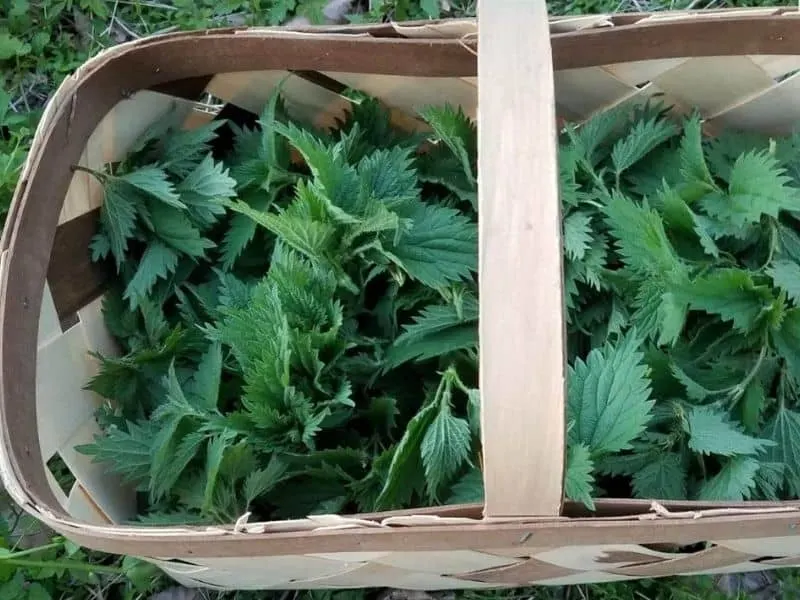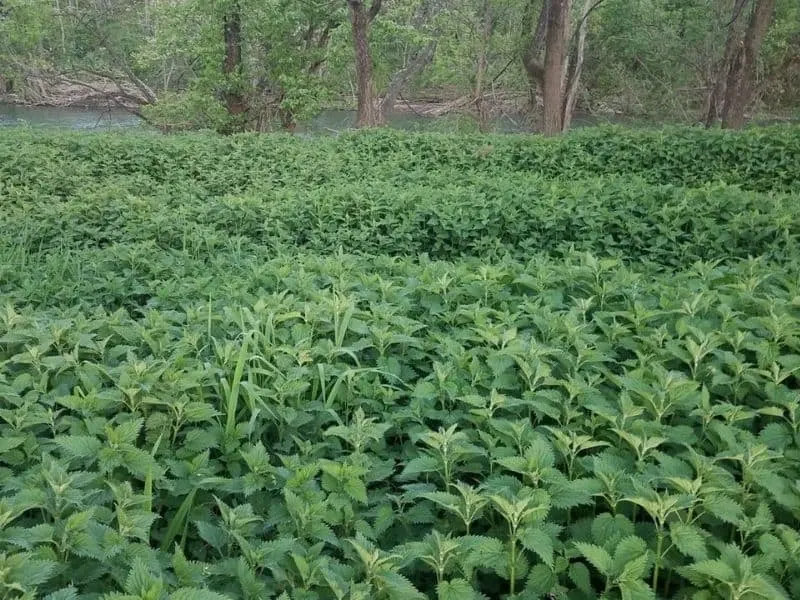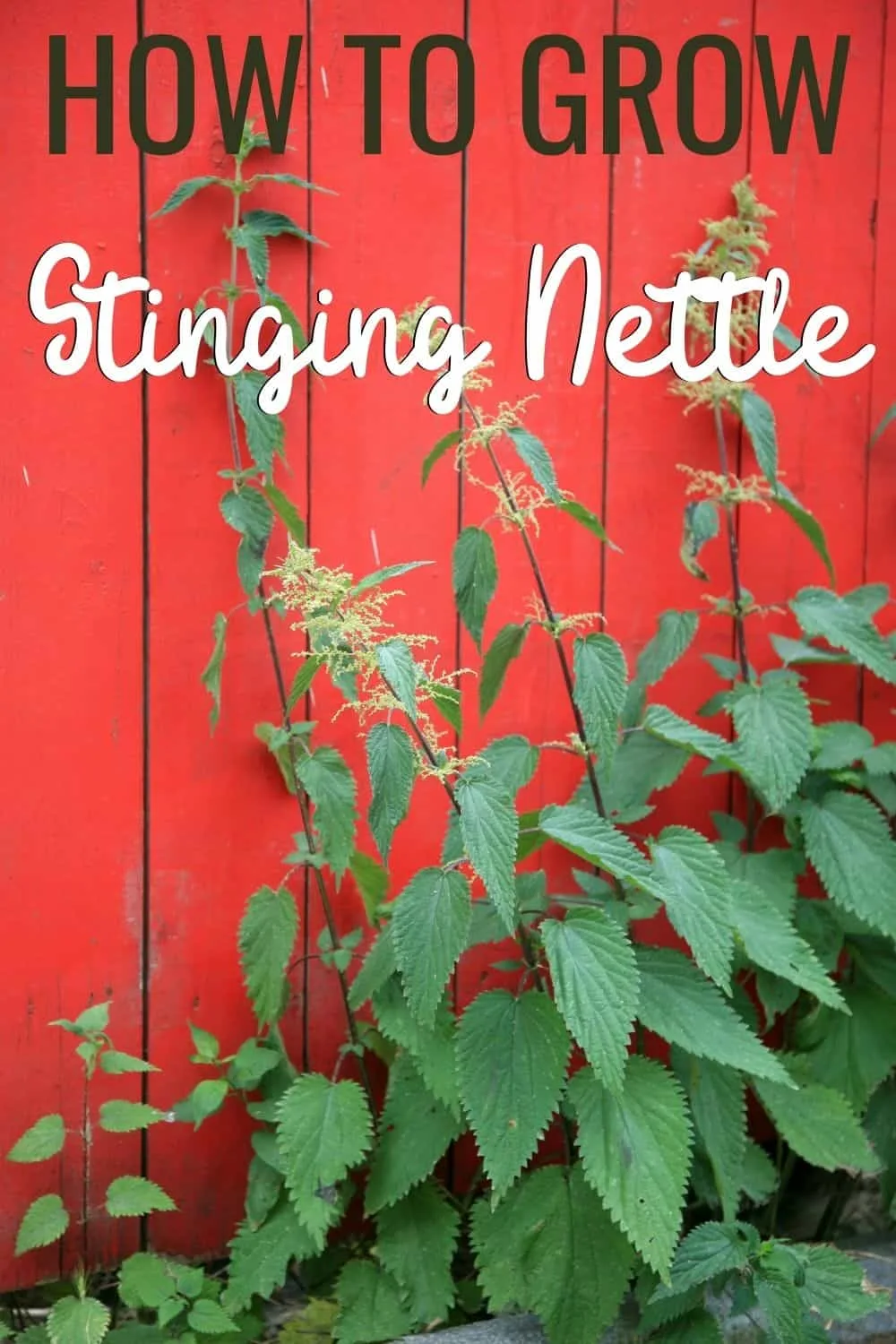Ever heard of stinging nettles? They are not only delicious but also good for you! We pick ours from the riverbank in town, but if you have the right conditions, learn how to grow stinging nettle: you’ll love it for teas, green smoothies, casseroles, and soups.

How To Grow Stinging Nettle
Stinging nettles (Urtica dioica) are a quirky plant to grow in the wetland garden, to be sure.

And despite the fact that they have stinging hairs, they are an extremely valuable plant to grow in the wet garden. Nettles are full of calcium and iron, and they are also widely used as a cleansing spring tea or as a steamed vegetable.
Food gardeners who have extremely wet gardens can find it hard to find edible plants that will thrive in their gardens. Growing stinging nettles in the damp or wetland garden turns this space into a thriving vegetable garden.
Best place to grow stinging nettles
Stinging nettles thrive in the wet garden. They are a vigorous and weedy plant in many places, and once they are invited into a part of the wetland garden the nettles love to stay and grow.
Choose a sunny location where the nettles will have damp roots. They love wet edges, and meadows to grow in. Plant them in a corner of the garden that is out of the way of children and pets, as they’ll sting and hurt if touched.
Planting stinging nettles
Plant inside at the end of winter, or straight in the garden in early spring. Seeds will need light to germinate, and plenty of moisture through the growing season. Once harvested, you can just ignore them, except for keeping them from spreading in places you don’t want them.
You can buy stinging nettle seeds from Amazon.
You can also divide existing plants if you’d rather not start from seed. Find a friend who grows them and ask to divide a few of their plants. Then add some mulch around your newly planted nettles to keep the moisture in easier.
How to recognize stinging nettle plants in the wild
Most people will not have a problem correctly identifying stinging nettle as it has a distinctive look and unmistakable sting.
Of course, if you’d rather recognize the nettles before you feel the sting, you should look for three-leaf clusters of heart-shaped, long, coarsely toothed, thick leaves growing opposite one another on stiff stalks. The stems and the back of the leaves have fine hairs that when touched are very painful. Nettle plants usually grow up to 3 ft tall.
Harvesting stinging nettles
The tastiest leaves are the small, young leaves. They are best harvested in March and April. However, you can harvest them much later by just snipping off the top few inches of the plant (preferably before it has flowered).
If you continue harvesting just the top leaves of the plant, then it will continue to have tender young leaves far later in the year, and you will be able to have a new crop of nettle leaves every few weeks.
You can eat the larger leaves, but they have a far tougher texture and are also more fibrous.
To harvest, make sure that you wear thick gloves, preferably leather, to avoid getting stung! Use scissors to cut the stalk of the plant, and gather them in a basket. Always gather more stinging nettles than you think that you will need. It is similar to spinach and shrinks drastically when cooked.
Although some people do not react strongly to the little stinging hairs of the nettle plant, many people do react. It is best to wear a sturdy pair of garden gloves when planting, tending to, and harvesting stinging nettles. I prefer to double glove, but you could use one of these thick long sleeves gloves.
Use hand pruners as well, since the nettles are often shallowly-rooted and may come out of the ground if pulled.
And don’t forget to wear long sleeves, long pants, and closed-toe shoes, so you have every inch of skin covered up.
Cleaning the nettles after harvest
When you prepare nettles for use, you need to keep your gloves on. Separate the leaves from the stalks (discard the stalks and any tougher or yellowing leaves, as well as any flowers).
Then wash the leaves. We wash them 3 times to make sure we get rid of all soil and bugs.
The next step is blanching for a couple of minutes, before using them in soups or other dishes. Of course, if you decide to dry them for tea making, you’ll skip this step.
How to use stinging nettles
Stinging nettles are a tasty and nutritious addition to a wide variety of meals. Because they haven’t been farmed, transported, or packaged, eating nettles is good for the environment. As they grow profusely and you can pick them yourself for free, nettles are good for your wallet as well.
They are a versatile plant that can be used in many ways:
- make teas
- add to soups
- make sauces and pesto
- add to green smoothies
- add to savory cookies and muffins
- rinse your hair
Drying stinging nettles for tea
If you want to dry stinging nettle, the best method is to use a dehydrator (I love my Excalibur dehydrator!) and then store it in an airtight container. Then you can use the dried leaves to make an herbal tea, or used the dried leaves in cooking later.
Another way to dry nettles is to hang them upside down in a shady, breezy spot. Cut the nettle plant near its base. Do this on a sunny day if at all possible, or the nettles will be very damp. Collect several plants together and tie them at the base, hanging them upside-down for good airflow.
After a week when the nettles are completely dry, remove the leaves and crush the plants. Store them in containers as nettle tea.
Steaming stinging nettles for soup
Nettles have a rich, earthy taste that is a wonderful complement to lighter flavors like lemon and milk. They taste glorious when they are pureed in a soup.
Take care when storing and moving the nettles into a pot, since they can sting until they are steamed. Steam the nettles until they are somewhat limp and bright green (the sting will be gone as soon as the plant is dunked in hot water). Puree them into soups or use them like chard in stir-fries.
We gather as much as we can during the spring and freeze it after balancing. Then come winter, we LOVE the freshness it brings to our table 😉
FAQs about stinging nettles
Where can I get stinging nettle seeds?
If you live by a river that has nettles growing wild, stop by towards the end of summer and gather some seeds. Or, go to amazon and order some.
How long does it take for stinging nettles to grow?
If you plant from seeds, nettles take about 85 to 90 days to maturity. Of course, since they are perennial (an aggressive spreader in some areas), once you plant them, all you need to do is wait for spring.
Is stinging nettle a perennial?
Yes, the stinging nettle plant is perennial. It also self-seeds and spreads quickly.
Can you grow nettles in pots?
You can, and in some cases (if you don’t want them to spread) you may want to. Growing stinging nettles in containers can also be beneficial if you host outdoor gatherings: you can just pick your containers and move them out of the way 😉
How do you treat a stinging nettle sting?
If you touched stinging nettle, your skin will become itchy, painful, and sometimes (if you touch it multiple times), your skin can get numb for up to 24 hours.
To alleviate the itch and pain, wash the area with warm, soapy water to get rid of the hairs that caused the reaction, then apply a thin layer of an antihistaminic cream. If you don’t have that handy, icing the area might help, as well as banking soda paste (made with water).
In rare cases, you can have a much stronger reaction and should reach out for medical help
Stinging nettles are a nutritious spring food, and they are also an excellent edible plant to grow in the wetland garden. Harvest them frequently to tame the nettle patch and ensure that the existing plants grow vigorously.

Adriana Copaceanu is a passionate nature lover living in the country on her dream property where she grows vegetables, lavender, and wildflowers that she shares with the wildlife they attract. When she's not in the garden, she loves spending time with her chickens and planning her next nature project. Check out her books below:
How to Grow Lavender for Fun and Profit: Lessons Learned from Planting Three Hundred Lavender Plants

Marianne
Sunday 12th of February 2023
This plant is a typical sign of spring in Sweden. We use them to make a soup with half a boiled egg in it.
Adriana
Sunday 12th of February 2023
I am from Romania and we make a mush/cream out of it and eat it with polenta, garlic, and eggs. It's delicious!
5 Easy Edible Landscaping Ideas
Wednesday 17th of August 2022
[…] Have a wet spot in your garden? Grow some stinging nettle. […]